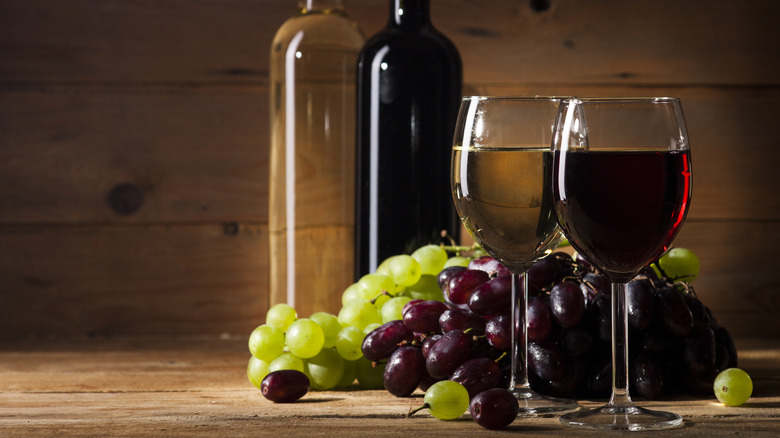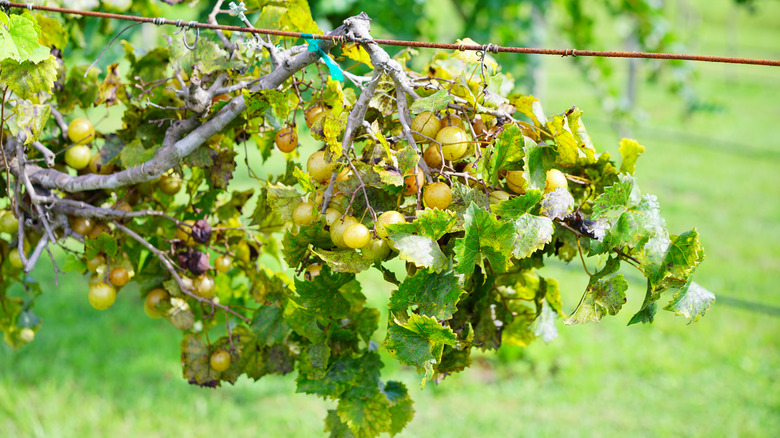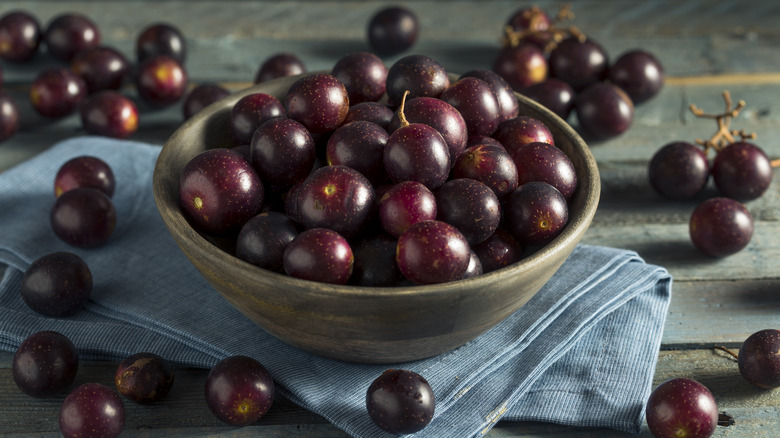Muscadine Wine: The Sweet Drink That Takes A Special Type Of Grape
People have been drinking wine for thousands of years. Though the boozy beverage has come to be associated with Europe, the first recorded examples of the fermented drink come from 7000 BCE China. Early wines were likely made from a variety of foods, but grapes quickly became a standard wine base, and have remained the main ingredient.
Wine isn't inherently made out of grapes though. There's Tej, the Ethiopian honey wine with ancient origins that is still sipped on today. Wine can also be made out of carrot, dandelion, and maple. However, if you're in the market for an alternative bottle, you don't need to leave the grape family entirely. In the American South, the massive, spherical muscadine grape is used to make muscadine wine. Over 100 iterations of muscadine grape can be found in the U.S., though relatively few are ever turned into wine. The wine made from these grapes is generally made rather sweet and has a potent aroma, but there is a wide variety of flavor profiles in the muscadine wine family. This peculiar piece of produce has a fascinating history and it may represent the future of fine wine.
The history and science of muscadine wine
Muscadine wine can all be tied back to the Mother Vine, a plant estimated to be 400 years old that resides on North Carolina's Roanoke Island. This vine is likely the common ancestor of all muscadine grapes in the region, including North Carolina's state fruit, the scuppernong grape, which is often used to make delicious scuppernong pie. In the early 1800s, North Carolina was the largest producer of wine in the country, and the state earned this spot entirely on the back of the muscadine grape.
Muscadine grapes are an incredibly unique fruit. They have a higher concentration of polyphenols, a chemical in grape skin that is responsible for red wine's color, and also ellagic acid, which is not in most wines. Healthline tells us that ellagic acid is an antioxidant with a slew of health benefits like fighting free radicals and even combating cancer. These chemicals are a result of the muscadine grape's thick skin, whose bitter flavor affects the taste of the wine. This means that more sugar is generally mixed in during the winemaking process, resulting in a sweeter bottle. If the idea of an overly sweet bottle doesn't sell you on muscadine, you should know that this wine is not limited to solely sweet reds. White wine and rosé are also often produced from the muscadine grape family. However, dry bottles of muscadine wine are uncommon, to say the least, because of the aforementioned thick grape skin.
The future of muscadine wine
If you have an aversion to sweet wines, you should still try a taste of this unique drink. In fact, muscadine wine isn't necessarily as overtly sweet as it once was because modern winemakers have a better understanding of how to ferment the fruit and no longer simply stir in excess sugar to combat the grape's bitter bite. Muscadine wine is also at its best when poured shortly after it's been bottled and served chilled.
Though the thick skin of these grapes affects their flavor, this protective peel may be what makes muscadine the wine of the future. It makes the grape less prone to rotting and better equipped to keep out diseases. The fruit is also better at combating phylloxera, an insect that destroyed countless European vineyards in the 1800s. As the climate continues to change, many wines may become more difficult to make, but the comparatively low maintenance and more robust muscadine grape will be less susceptible to these climatological challenges.
Climate concerns aren't the only reason why muscadine wine may be the drink of the future. For instance, a brewer could be set back as much as $2,000 for a ton of Pinot Noir grapes, while the same size shipment of muscadine grapes will cost just $300. A wine made from cheap grapes that is better suited to the changing climate is definitely a wise investment for vintners everywhere.


